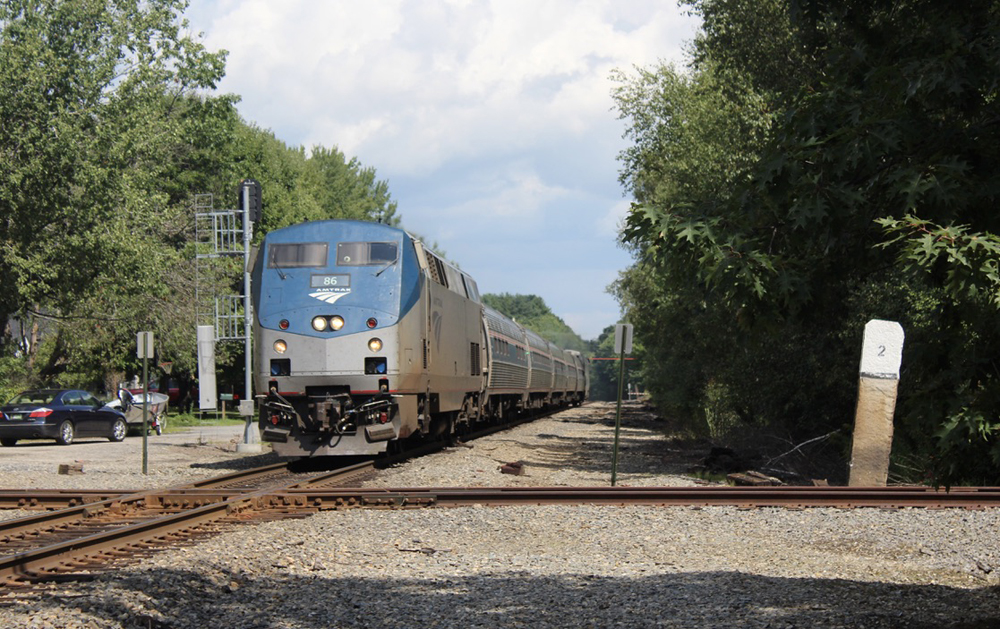
AUBURN, Maine — An Aug. 25 hearing before a Maine Department of Transportation advisory council heard conflicting proposals to use 25 miles of idle state-owned tracks for a Portland-Auburn commuter rail system, or to remove those tracks to create a trail.
Meanwhile, a Canadian-based organization, the Night Trains Foundation, has suggested yet another use: as a key link in an overnight passenger train from Montreal to Boston.
Rail, trail advocates jockey for position
As part of the state’s passenger rail service plan submitted to the Federal Railroad Administration in 2019, Maine commissioned an “Economic Evaluation Study for Commuter and Passenger Train Service Between Portland and the Lewiston-Auburn area.” With the survey’s findings expected to be released next month, rail and trail advocates outlined their respective plans to the DOT’s Portland-to-Auburn Rail Use Advisory Council
A Maine Rail Transit Coalition presentation attempts to make the case for “battery-operated trains” that would run on the former Grand Trunk tracks, where Genesee & Wyoming’s St. Lawrence & Atlantic holds the freight franchise. Albert Fazio, P.E., who has extensive experience with NJ Transit’s Camden-Trenton River Line and Amtrak before joining BRT Services, LLC, as a consultant, told the committee, “If you can’t see it and touch it, you can’t see what we are proposing here.”
The coalition’s argument is that the short line is an ideal candidate for frequent rail service precisely because there are currently no freight customers south of Auburn.
This counters the premise advanced by the Casco Bay Trail Alliance that a parallel, active former Maine Central route, operated by CSX following its acquisition of Pan Am Railways, is available for passenger trains. A portion north of Portland was upgraded with 2009 economic stimulus funds to host Downeaster trains to and from Brunswick, Maine, but capacity and track improvements — as well as a new agreement with CSX — would be required to initiate passenger service. In any case, trains on that route wouldn’t operate frequently throughout the day, as in the Transit Coalition proposal.
The Eastern Trail Alliance points to the popularity of a well-patronized trail south of Portland to Kennebunk, Maine, as well expressions of support from communities along the line to Auburn, as evidence that this is the best solution. However, both Genesee & Wyoming and the Transit Coalition have stressed the importance for preserving the line for future freight use.
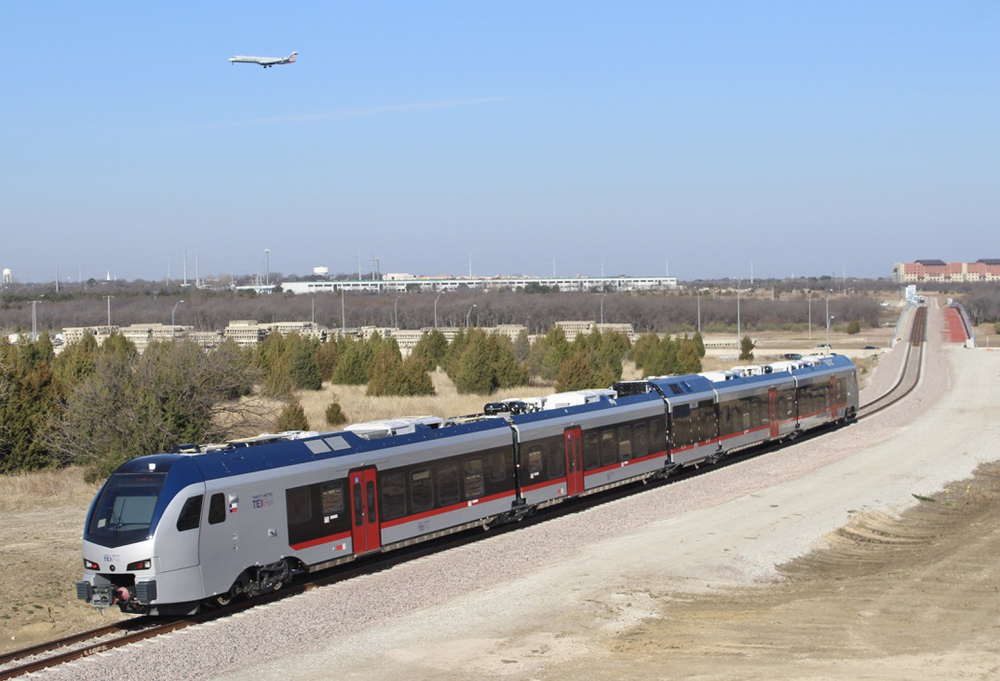
A yet-to-be-determined amount of public investment will be necessary for both alternatives. In rail’s case, long-dormant tracks will at a minimum require new ties and surfacing; accessible stations will need to be constructed and equipment procured.
A number of commuter rail systems, as well as New Jersey’s River Line light rail, operate diesel multiple unit (DMU) trainsets. But Stadler, whose FLIRT DMUs are used in Texas on Trinity Metro’s TEXRail line between downtown Fort Worth and DFW Airport, has recently developed an electric version whose mid-trainset battery-equipped unit can be swapped for diesel power. Existing battery applications also include Detroit’s Woodward Avenue Q Line streetcar, where svehicles draw and store electric power from overhead wire for use on stretches where catenary isn’t present.
Overnight proposal faces significant challenges
Preserving the railroad would also be a prerequisite for initiating a Montreal-Boston overnight train, which could conceivably coexist with a daytime commuter rail operation. The Lewiston Sun Journal reports the Night Trains Foundation is seeking “agreements with Canadian Pacific and Genesee & Wyoming…and (preliminary) talks with the American firm are going well.” The proposed 14-hour schedule would include intermediate Maine stops at Bethel, Auburn, Portland, and Old Orchard Beach; locals refer to the resort town as the “Canadian Riviera” because so many tourists from Canada vacation there in the summer. In winter, Bethel is a major ski destination.
Canadian National’s Grand Trunk subsidiary ended daily Montreal-Portland, Maine, passenger service in the early 1960’s but continued to operate a summer weekends-only “Passenger Special” round trip until 1967. The 1963 version departed Montreal at 10 p.m. Friday and arrived into Grand Trunk’s Portland waterfront station at 6:20 a.m. Saturday, before returning to Montreal that afternoon. Maine Narrow Gauge has operated the isolated downtown remnant following a fire that destroyed Grand Trunk’s Back Cove trestle in 1984.
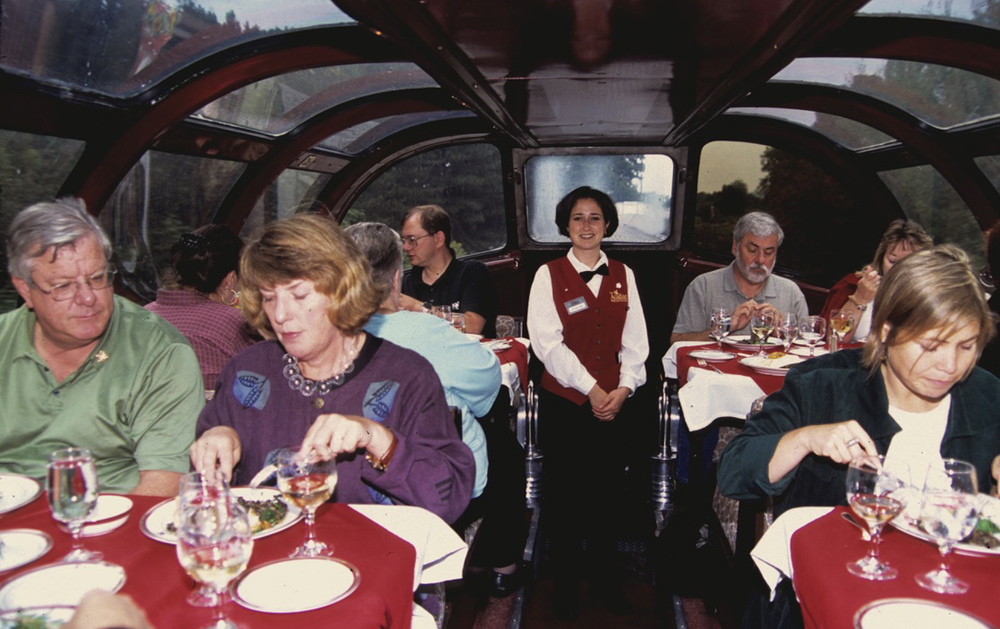
A summer-fall excursion concept was briefly revived on the route in 2002 when Randy Parten launched the Acadian, a daytime Montreal-Portland cruise train featuring meals served in heritage domes acquired by the Texas businessman. But the service never attracted a critical mass before 2003’s SARS outbreak contributed to its demise. Speeds on that run rarely exceeded 30 mph.
There are many obstacles to initiate passenger service today. The 1963 Montreal-Portland travel time was scheduled at 8 hours, 20 minutes, but track conditions have further deteriorated since then. The first phase of the project is targeting the Montreal- Sherbrooke, Quebec, segment for frequent commuter service, but no costs have been developed for that or necessary U.S. investments. Although the Night Train Foundation advocates “envision 120 passengers in sleeper cars and 70 in coach seating” for the overnight run, securing surplus road-worthy rolling stock today is a tall order.
Additionally, a track connection would need to be constructed at Yarmouth Junction, where the St. Lawrence & Atlantic crosses the CSX route used by the Downeaster. (The Maine rail group is proposing a station here.)
Plans to link Montreal and Boston have been floated previously; turning the Auburn-Portland segment into a trail would forever preclude any such service. But the main task for the Maine Department of Transportation once the study is released will be enhancing public mobility in an increasingly congested part of the state. The rail-versus-trail outcome hangs in the balance.
— Updated at 9 p.m. CDT to restore words dropped from paragraph beginning “A Maine Rail Transit Coalition presentation …”






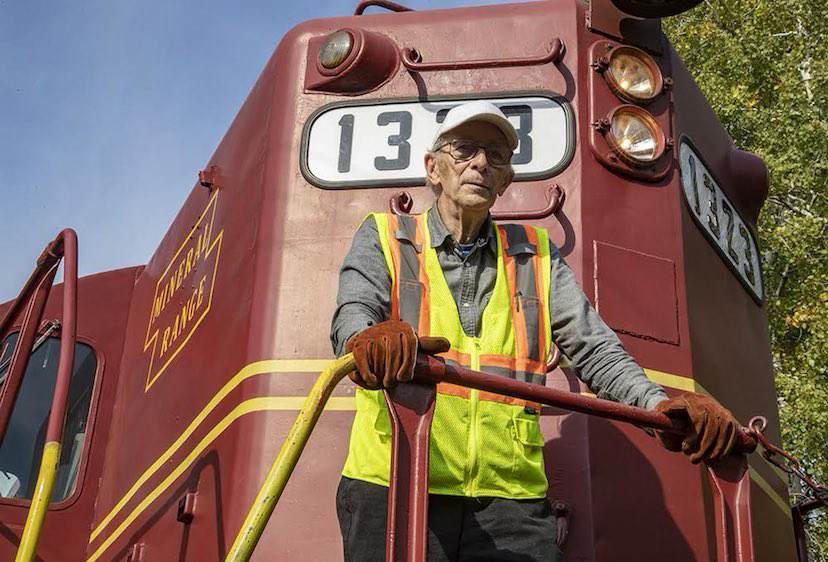
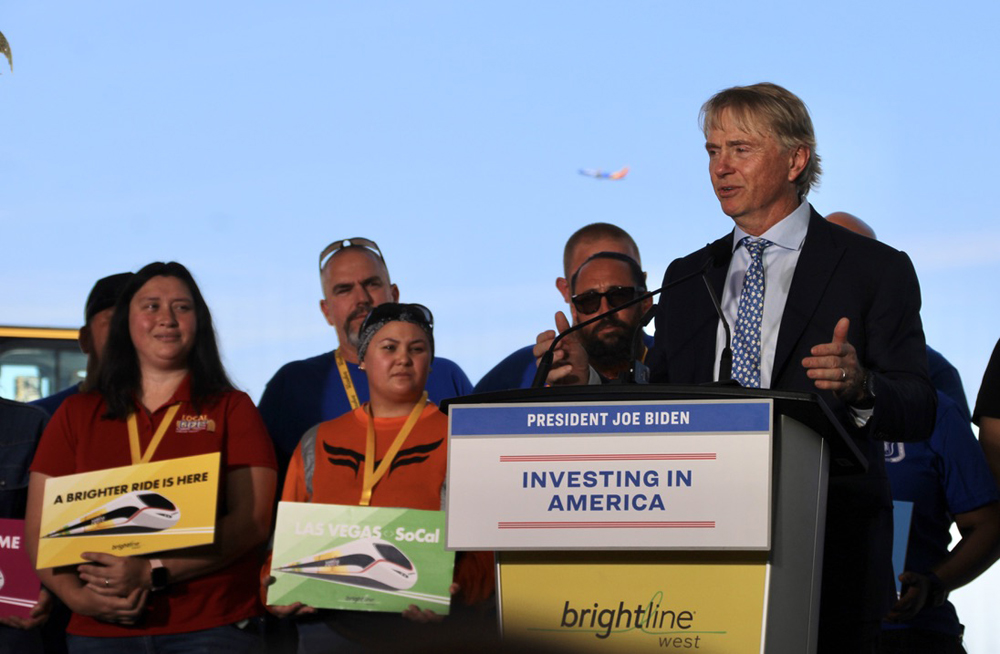
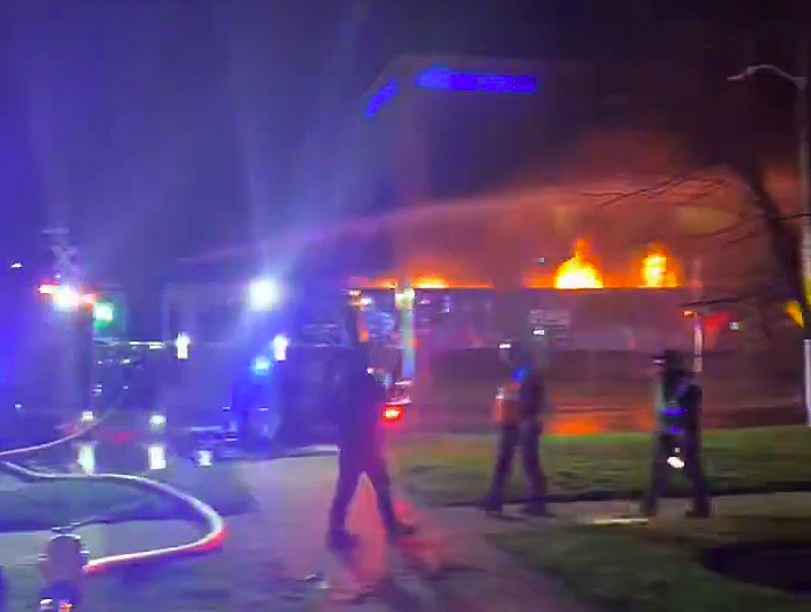
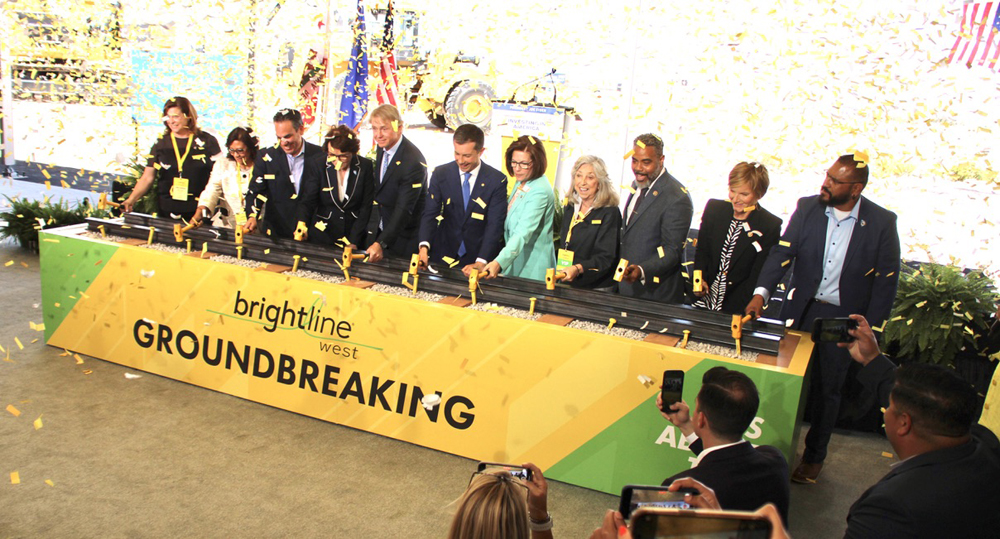




I agree with the rails and trails concept but in this case the segment from Danville Jct. south to Portland might just as well be turned into a trail as the only customer on the line is gone and its site is being turned into a research institute (Roux). This is Maine and nothing that would require rail service will be built along this line. The NIMBYs in this state scream and protest if you want to build a dog park let alone heavy industry. Plus, the area where the line ends is now no longer in downtown Portland but a commercial area of light industry and offices. (The former GT round house and other railroad buildings are still there but converted to other uses.) Any trip to downtown would have to be by cab or Uber or scanty public transit. To replace the bridge across the entrance to Back Bay would cost millions and make the concept of commuter service way too expensive. The Amtrak station is too far from downtown to be easily walkable and would require a two-seat ride so those that are proposing commuter service are dreaming. The roads for the most part are not that congested. Portland only has about 65,000 people with about 200,000 in the metro area. Maine is very car centric, and I can’t see that changing any time soon. The Montreal – Boston service is also not likely to happen. Track speeds are too low, and the transit time would be too long for it to be competitive with automobile let alone the plane. The millions required to upgrade the track, buy new equipment and do the mitigation required to mollify the NIMBYs is not available in public funds, and I doubt the private sector would take the risk.
There’s a trail that starts in Newark, OH, and is adjacent to the former Pennsy Panhandle line, former Penn Central/Conrail/Ohio Central and now a G&W property. The trail is built on the former No. 2 main and a fence separates it from the remaining main track. There’s never been a problem that I’m aware of. Since G&W has taken control of the line traffic has greatly increased and I believe NS either has trackage rights or G&W runs the NS trains with their own crews. Could be wrong on NS. Trains can be long but G&W limits trains on this route to 30 max. Amtrak’s National Limited ran over this and the line was cab signaled in its heyday. My problem with Rails to Trails and why I don’t support them is they seem to be quick to want to pull the rails up and not so interested in preserving a corridor for future rail service. There are the exceptions where rail will obviously never return. But I believe that in any case something needs to be agreed to that allows rail to easily return. If there is a need for future rail service it shouldn’t involve the numerous lawsuits and endless litigation that general ensues.
Mr. CARBONETTI: ” I believe that a trail is adjacent to a portion of Western Maryland Scenic.”
Mr. LASZEK: Indeed there is. It’s part of the Great Allegheny Passage. I’ve seen bikers and hikers on the path while riding the tourist train. Trains and trail pass through Brush Tunnel. Where the trail and the WMSR approach Frostburg, the trail peels off and heads toward Pittsburgh after escorting the rails all the way from Cumberland.
Actually I was a reular rider on a bike trail that was a the grade of the second track where one track remained in very occasional low-speed service. This was long ago. No separation, no fence. This was on the north side of Milwaukee, the remnant of a CNW main line that was kept single-track for one customer, a paper recycling warehouse. When the Milwaukee Fire Department forced the warehouse to close, the track was ripped up.
Same issue exists in the Santa Cruz area. Why can’t one share? There is plenty of room for both.
NJ Transit’s Camden-Trenton River Line – 4th paragraph – this does not seem to be part of the article. Please edit.
Sorry about that–a line got left out in posting on the road so a correction on the text will follow. Meanwhile, the paragraph should read:
Maine Rail Transit Coalition presentation attempts to make the case for “battery-operated trains” that would run on the former Grand Trunk tracks, where Genesee & Wyoming’s St. Lawrence & Atlantic holds the freight franchise. Albert Fazio, P.E, who has extensive experience with NJ Transit’s Camden-Trenton River Line and Amtrak before joining BRT Services, LLC, as a consultant, told the committee, “If you can’t see it and touch it, you can’t see what we are proposing here.”
I too was non-plussed by that reference to NJTransit in that paragraph. Thank you Mr. Johnson for the correction. (Further down there’s a “CSK” typo. I wish you could have included a map showing all the lines you referred to. Yeah, I could grab the appropriate SPV rail atlas or gone to openrailwaymaps.com…Meanwhile, it seems battery-powered trains, be they locomotives or MU equipment are far from being ready for prime time. Maybe the folks at Maine Rail Transit Coalition need to cool their jets until this technology become further developed before making starry-eyed proposals. Let’s go with DMUs like the Stadler FLIRTs first and see how things develop. Anyone wanting to see FLIRTs in action all over the place, try watching RailCowGirl cab ride YouTube videos. RCG, a locomotive engineer in Norway who mostly works the Oslo-Bergen Line, has gone to freight service. But a host of cabride videos she made while in passenger service are available at her site and you’ll be treated to the FLIRTs she ran and the ones her trains meet out on the road. Hint: They’re all EMUs.
A ROW converted to trail cannot generate tax revenue. Who is forgeting this?
Neither does an abandoned ROW.
Follow the money…
The Earth is wobbling in its orbit. The less realistic a passenger train proposal is, the less it makes sense in the marketplace of real-world economics, the more the enviros push battery power or other greenie suggestions like hydrogen. A train running at 40 mph on third-rate track through the Maine wilderness won’t have any better luck than Benedict Arnold’s ridiculous invasion of Canada through northern Maine during the Revolutionary War.
I have read the famous April 1959 edition of TRAINS MAG. No, I’m not that old. Many years after 1959 I located a copy in the U-Michigan Transportation Library in Ann Arbor. I can’t remember if it was that edition, or an article in some later edition, that David P. Morgan made this point: Equipment didn’t cause the demise of passenger trains, and new generations of better equipment didn’t save it.
You can pour all the new technology (greenie or otherwise) into a train proposal that has zero legs, it will have zero legs.
It’s time to permanently change the Rails-to-Trails concept to Rails-and-Trails concept, whereas the trail is built next to the rail line and the rail line remains in place for future use…just build fences when you build the trail, problem solved(excludes idiots that climb over the fence, liability for the rail line is easily solved with a simple sign).
Yes, this seems like a very rational and viable suggestion. I have never understood why trail advocates often fight this concept. There are certainly examples where the rail and trail concept has worked. I believe that a trail is adjacent to a portion of Western Maryland Scenic. Of course, where brides and tunnels are involved, additional construction, and thus funding, is a factor, but that does not seem to be an absolute barrier.
That exact concept exists in Jim Thorpe, Pa where the rail line and a trail share a bridge with a fence between them, great idea.
Come to SE Wisconsin, location of numerous bike trails in all directions on former rail RW — ex-CNW, ex-MILW, ex-Milwaukee Electric. The New Berlin Recreation Trail, ex Electric, from West Allis to Waukesha, parallels what liitle is left of the ex-CNW line from West Allis to Madison. Not much is left, only a stub end for two or three New Berlin customers, but amazingly UPRR has changed out ties this year and rebuilt grade crossings. Over the many years I’ve bicycled in the area, I’ve only seen one train, but that’s enough for UP to keep the line in business.
You learn a lot biking on these trails. For example, how well-engineered were the CNW secondaries, but how skimpy the MILW branches.
Here in my home town of York, Pennsylvania we have the Heritage Rail Trail County Park which is mostly made up of the former Northern Central which was double tracked many years ago when it was a major passenger line for the Pennsylvania Railroad.The rail trail is on the track that was taken up right next to the remaining tracks that are still active (Yorkrail &Steam Into History). This rail trail has been opene for over 30 years and to the best of my knowledge there have never been any fatalties or serious injuries suffered by any hikers or bikers as a result of the trains that still ply these tracks.
That’s all well and good…until one of those trains winds up on it’s side and crushes a family out riding their bicycles.
Railroads, like power lines, are pieces of heavy industry that project outside of regulated reservations and through the backyards of middle America. Despite being part of the perceived landscape they carry inherent dangers that even the best maintenance cannot completely mitigate. As such the loitering time between the public and these rights-of-way needs to be minimized and certainly not encouraged.
Remember, every railroad is a linear superfund site. I spend time there because I’m paid to do so, know the hazards and take the necessary precautions. If you can see between the rails you are too close.
You apparently are unaware they’re all over the place already, not only in the U.S. but the U.K., and your scenario has not happened as of yet. That doesn’t mean it couldn’t happen, but the likelihood of such an event is one in a million, no make that one in a billion. most of these lines being proposed for conversion to trails no longer see service. This keeps the rails in place for the FUTURE, no harm done, and then almost none of them would be mainlines, therefore low speed operations. Rails-n-Trails should be the default, no ifs, ands or buts about it…take your one in a billion scenario and go hide under a rock, everything has potential to kill you.
I am more than aware of this and still do not like it. It only takes one incident to create a scandal, a scandal my business does NOT need.